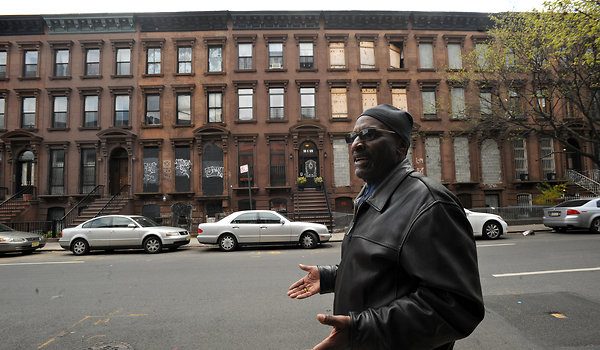Derrick Taitt and his neighbors tried to save the graffiti-covered building at 58 East 126th Street.
By CARA BUCKLEY
Published: April 15, 2012
Gentrification, or at the very least prettification, has reshaped block after block in Harlem, but it has not fully arrived at East 126th Street between Madison and Park Avenues.
There, handsome rows of century-and-a-half-old brownstones line the north and south sides of the street, just as they do one block west, on a pristine tree-lined stretch where homeowners keep polished doorknobs and spotless front stoops.
But along East 126th Street, vacant buildings are interspersed among the inhabited ones.
Their windows are boarded up or bricked over with cinder blocks. Chicken wire encircles a couple of the front stoops. One brownstone is fronted by ribbons of razor wire, though neighbors said people still lived there legally, they just went in through the back.
In the middle of the block, on the south side, sits No. 58, scrawled over with graffiti, stricken with a caving roof and collapsing floors, and deemed structurally unsound. The building is slated for demolition this month by the city, despite a nearby resident’s efforts to buy it and neighbors’ laments that the seamless row of houses will be punched through with a gap-tooth hole.
“Historical buildings should be saved,” said Michael Henry Adams, an architectural historian and the author of “Harlem: Lost and Found.”
“If a property is more valuable with its historic resources intact,” he said, “why would you let it get to a state where the only recourse is to demolish it?”
No. 58 has not been designated a city landmark, but, according to Mr. Adams, it has the potential to be, sitting on a brownstone block comparable to others with historical designations. It is also about a block and half from the former home of the poet Langston Hughes, 20 East 127th Street, which is a city landmark.
Despite a strong overall community sentiment that city money should go to restoring such buildings before they degenerate and become structurally dangerous, the city says it is not in the business of rescuing unsound, privately owned buildings.
“It’s always the private property owner’s responsibility to maintain the property,” said Eric Bederman, a spokesman for the city’s Department of Housing Preservation and Development, which is overseeing the demolition. “It is a critical part of what being a responsible owner is about.”
Property records show a troubled financial history for No. 58, which, according to Mr. Adams, was most likely built in the late 1860s for upper middle class whites. It was advertised for a sheriff’s sale in 1970, acquired by the city in 1980 through a tax foreclosure, sold at public auction two years later, and in 2006, was bought for $950,000 by a corporation called Parade Place LLC, of Brooklyn. Messages left with Saadia Shapiro, who is listed in public records as the corporation’s managing member, were not returned.
One neighbor, Derrick Taitt, who owns a brownstone on the north side of the street, said that No. 58 had sat empty for over two decades. In recent years, neighbors began calling the city’s 311 line as conditions deteriorated. Debris was falling. The roof was collapsing. Squatters were sneaking in and out of a large hole in the street level wall.
“It’s gotten worse in the last eight or nine months; street dwellers have been coming in,” said Michael Peterson, 44, who lives with his family in the top floor of No. 56, next door. “All of us collectively have been complaining.”
The brownstone on the other side of Mr. Peterson’s building is also vacant, which is troubling to him and his neighbors. No. 52-54, a double-wide, has long been a gathering point for vagrants, drug users and prostitutes, Mr. Peterson said. He and other neighbors recently bought supplies from a hardware shop and hammered together a wooden barrier with nails sticking out of the top to block the basement stairwell. They also lined the front fence with chicken wire.
“Prior to the sealing, it was really bad,” he said. “But we shouldn’t have to do that.” (According to property records, the building is owned by the William M. James Housing Development Fund Corp. Reached by phone, Mr. James, who is 96 and a former minister at Metropolitan Community United Methodist Church, across the street, said that there were plans to convert the building into a seniors’ center).
But though the buildings on either side have vexed Mr. Peterson, he does not want to see them torn down. “It’s just going to bring in more issues,” he said.
Mr. Taitt, who said he was on the board of the Community Association of the East Harlem Triangle, said he had tried repeatedly to contact the owner of No. 58 to make offers on the place, sending certified letters that got no reply.
“Another neighbor said, ‘Why don’t we get together and buy it?’ ” Mr. Taitt said. “The owner doesn’t want to talk.”
After inspections by the city departments of housing and buildings found further problems at No. 58 — a teetering rear brick wall, more roof cave-ins, a collapsed floor — they issued a declaration to demolish in late March. A spokesman for the housing department said that demolition work would most likely begin in two weeks, and that the property owner would be billed.
Neighbors suspect, warily, that after the building is torn down, a bland, boxlike structure will rise in its place: the property owners may build whatever they please, so long as they comply with zoning requirements and the building code.
Already, neighbors are girding for the loss.
“These buildings have personality,” said E. Wayne Tyree, 70, a poet who lives nearby. “This will change the whole beauty of the thing.”
Jack Begg contributed reporting.




